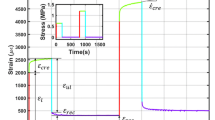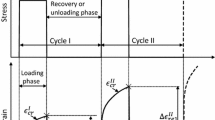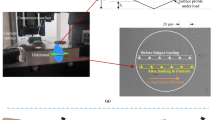Abstract
Uniaxial tensile tests were performed on standardised longitudinal specimens of bovine compact bone at strain rates from 5·3×10−4 to 237 s−1. After testing, the microstructure and dry density of each specimen was determined. The test results demonstrated highly significant (P<0·01) positive correlations between ultimate strength and strain rate, and between ultimate strength and density. A highly significant negative correlation between ultimate strength and the extent of secondary Haversian remodelling was also found. The modulus of elasticity showed similar correlations with the test parameters. A multiple linear-regression analysis was used to derive equations for the ultimate strength and modulus as functions of strain rate and microstructure. The regression analyses accounted for 86% of the variance in strength and 50% of the variance in modulus. The extent of secondary Haversian remodelling showed a significant (P<0·01) negative correlation with the energy-absorption capacity. Strain rate also had a significant effect on the energy-absorption capacity. Specimens tested at higher strain rates generally absorbed more energy during failure. There was no evidence of a critical velocity at which the energy absorption capacity attained a maximum. The test results correlate well with previous studies of the mechanical properties of compact bone.
Sommaire
Des essais de traction suivant un seul axe ont été effectués sur des spécimens longitudinaux, standardisés d'os bovin compact sous des taux de contraintes de 5,3×10−4 à 237s−1. Après les essais on a déterminé la microstructure et la densité à sec de chaque échantillon. Les résultats d'essai ont montré des corrélations positives fort significatives (P<0,01) entre la résistance de rupture et le taux de contrainte, et entre la résistance de rupture et la densité. On a trouvé également une corrélation négative fort significative entre la résistance de rupture et le degré de transformation haversienne secondaire. Le module d'élasticité a montré des corrélations similaires avec les paramètres d'essai. Une analyse par rebroussement linéaire multiple a été pratiquée pour faire des équations de la résistance à la rupture et du module en fonction du taux de contrainte et de la microstructure. Les analyses par rebroussement ont expliqué 86% de la variation de résistance et 50% de la variation du module. On a trouvé une corrélation négative significative (P<0,01) entre le degré de transformation haversienne secondaire et la capacité d'absorption d'énergie. Le taux de contrainte a eu également un effet significatif sur la capacité d'absorption d'énergie. Les échantillons soumis à des taux de contrainte plus élevés ont généralement absorbé plus d'énergie lors de leur défaillance. Les essais ne font pas ressortir une vitesse critique où la capacité d'absorption d'énergie atteint sa valeur maximum. Les résultats d'essai correspondent bien aux études antérieures des propriétés mécaniques des os compacts.
Zusammenfassung
Einachsige Zugversuche wurden an standardisierten Längsproben von Rinderknochenrinde bei Beanspruchungen von 5, 3×10−4 bis 237 s−1 vorgenommen. Nach der Prüfung wurden Mikrostruktur und Trockendichte jeder Probe festgestellt. Die Prüfergebnisse zeigten hochgradig bedeutende (P<0,01) positive Wechselbeziehungen zwischen der endgültigen Festigkeit und der Beanspruchung und zwischen endgültiger Festigkeit und Dichte. Eine hochgradig bedeutende negative Wechselbeziehung zwischen endgültiger Festigkeit und dem Ausmaß der sekundären Haversschen Umwandlung wurde ebenfalls festgestellt. Das Elastizitätsmodul zeigte ähnliche Wechselbeziehungen mit den Testparametern. Eine mehrfache lineare Regressionsanalyse wurde verwendet, um Gleichungen für die Reißfestigkeit und das Modul als Funktionen von Beanspruchung und Mikrostruktur abzuleiten. Durch die Regressionsanalysen wurden 86% der Festigkeitsvarianz und 50% der Modulvarianz bestimmt. Das Ausmaß der sekundären Haversschen Umwandlung zeigte eine bedeutende (P<0,01) negative Wechselbeziehung mit der Energie absorptionskapazität. Die Beanspruchung hatte auch einen bedeutenden Einfluß auf die Energieabsorptionskapazität. Proben, die unter höherer Beanspruchung geprüft wurden, absorbierten im allgemeinen mehr Energie während des Versagens. Es lag kein Beweis für eine kritische Geschwindigkeit vor, bei der die Energieabsorptionskapazität einen Maximalwert erreichte. Die Prüfergebnisse lassen sich gut zu früheren Untersuchungen der mechanischen Eigenschaften der Knochenrinde in Bezug setzen.
Similar content being viewed by others
References
Amtmann, E. (1971) Mechanical stress, functional adaptation and variation of structure of the human femur diaphysis.Ergebn. Abat. 44, 1–89.
Bonfield, W. andDatta, P. K. (1974) Young's modulus of compact bone.J. Biomech. 7, 147–149.
Bonfield, W. andLi, C. H. (1966) Deformation and fracture of bone.J. Appl. Phys. 37, 869–875.
Burstein, A. H. andFrankel, V. H. (1968) The viscoelastic properties of some biological materials.Ann. N. Y. Acad. Sci. 46, 158–165.
Burstein, A. H., Reilly, D. T. andFrankel, V. H. (1973) Failure characteristics of bone and bone tissue. In:Perspectives in biomedical engineering, Ed.Kenedi R. M. 141–134. University Park Press, London.
Carter, D. R. andHayes, W. C. (1976) Fatigue life of compact bone—I effects of stress amplitude, temperature and density.J. Biomech. 9, 27–34.
Carter, D. R., Hayes, W. C. andSchurman, D. J. (1976) Fatigue life of compact bone—II effects of microstructure and density,Ibid. J. Biomech. (to be published).
Cooke, F. W., Zeidman, H. andScheifele, S. J. (1973) The fracture mechanics of bone—another look at composite modelling.J. Biomed. Mat. Res. Symposium,4, 383–399.
Crowninshield, R. D. andPope, M. H. (1973) The response of compact bone in tension at various strain rates.Ann. Biomed. Eng. 2, 217–225.
Currey, J. D. (1959) Differences in the tensile strength of bone of different histological types.J. Anat. 93, 87–95.
Currey, J. D. (1975) The effects of strain rate, reconstruction and mineral content on some mechanical properties of bovine bone.J. Biomech. 8, 81–86.
Evans, F. G. (1973)Mechanical properties of bone, Charles C. Thomas, Springfield, Ill.
Hasson, D. F. andArmstrong, R. W. (1974) A ductilebrittle transition in bone.J. Mat. Sci. 9, 1165–1170.
Heřt, J., Kučera, P., Vávra, M. andVoleník, V. (1965) Comparison of the mechanical properties of both the primary and Haversian bone tissue.Acta Anat. 61, 412–423.
McElhaney, J. H. (1975) Private communication.
McElhaney, J. H. andByars, E. F. (1965) Dynamic response of biological materials. ASME 65 WA/HUF-9.
McElhaney, J. H., Fogle, J., Byars, E. F. andWeaver, G. (1964) Effect of embalming on the mechanical properties of beef bone.J. Appl. Physiol. 19, 1234–1236.
Panjabi, M. M., White, A. A. andSouthwick, W. O. (1973) Mechanical properties of bone as a function of rate of deformation.J. Bone Jt. Surg. 55A, 322–330.
Polakowski, N. H. andRipling, E. J. (1966)Strength and structure of engineering materials, Prentice-Hall, Englewood Cliffs, NJ.
Reilly, D. T., Burstein, A. H. andFrankel, V. H. (1974) The elastic modulus for bone.J. Biomech. 7, 271–275.
Saha, S. (1973)Tensile impact properties of bone and their relation to microstructure Ph.D. thesis, Stanford University.
Saha, S. andHayes, W. C. (1974) Instrumented tensile-impact tests of bone.Exp. Mech. 14, 473–478.
Sedlin, E. D. andHirsch, C. (1966) Factors affecting the determination of physical properties of femoral cortical bone.Acta Orth. Scand. 37, 29–48.
Sweeney, A. W., Kroon, R. P. andByar, R. K. (1965) Mechanical characteristics of bone and its constituents. ASME 65 WA/HUF-7.
Wall, J. C., Chatteri, S. andJeffery, J. W. (1972) Human femoral cortical bone: a preliminary report on the relationship between strength and density.Med. & Biol. Eng. 10, 673–676.
Author information
Authors and Affiliations
Rights and permissions
About this article
Cite this article
Wright, T.M., Hayes, W.C. Tensile testing of bone over a wide range of strain rates: effects of strain rate, microstructure and density. Med. & biol. Engng. 14, 671–680 (1976). https://doi.org/10.1007/BF02477046
Received:
Accepted:
Issue Date:
DOI: https://doi.org/10.1007/BF02477046




